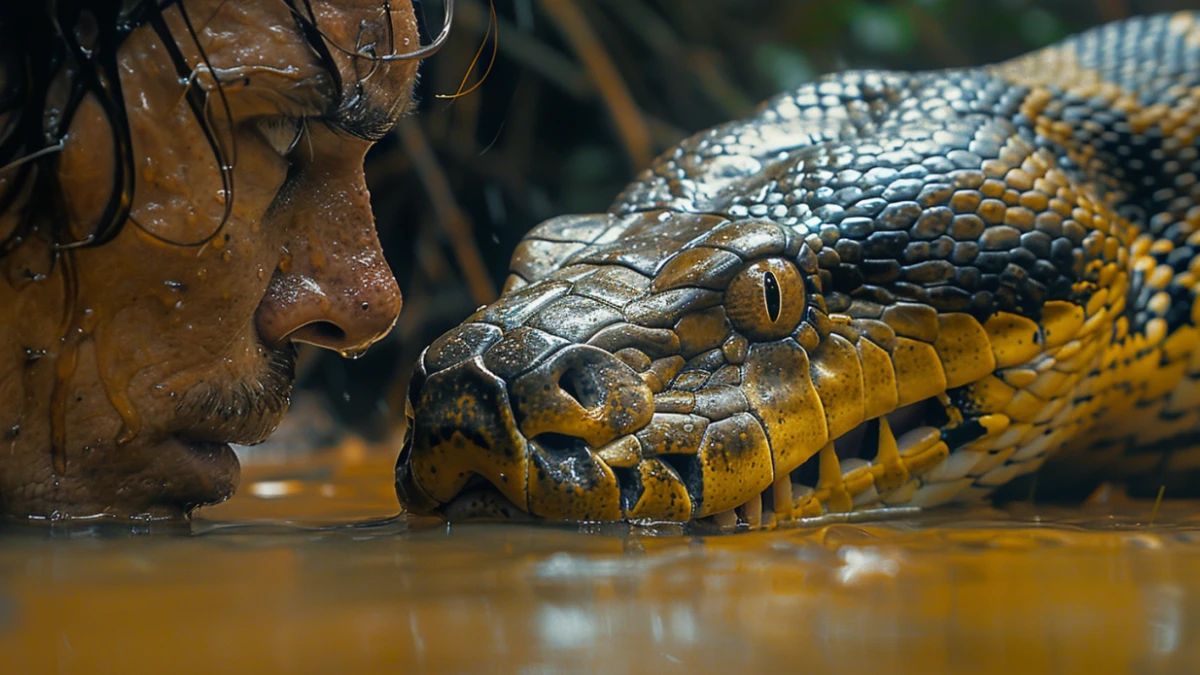
What's the Biggest Anaconda in the World?
The world's heaviest and largest snake in terms of length is the green anaconda. These enormous snakes, which are native to South America, can reach lengths of over 29 feet, weights of over 550 pounds, and diameters of over 12 inches.

It's interesting to note that female anacondas are much bigger than males. Dark oval dots line the spine of their olive-green bodies, while similar spots with yellow centers show up along the sides. In gloomy waters, their black and yellow belly scales aid in camouflage. They also have two dark stripes that go from their eyes to their jaws, which helps them hunt covertly.
| Scientific Name | Eunectes Murinus |
| Family Name | Boidae |
| Lifespan | 10 years |
| Weight | Upto 227kg |
| Length | 6 to 9m |
| Habitat | Swamps and rivers of tropical South America |
What is Special About Anaconda?
Green anacondas are among the largest snakes in the world, with females being significantly larger than males. They can grow up to 30 feet (9 meters) in length, reach a diameter of 12 inches (30.5 centimeters), and weigh as much as 550 pounds (250 kilograms).
Anacondas use their tongues to pick up chemical cues from other animals in their immediate vicinity because they have highly developed chemosensory abilities. During the breeding season, men also depend on their capacity to detect pheromones from females. They can find possible mates by using their tongues to detect chemical clues in the atmosphere.
What are 5 Facts About Anacondas?
Largest and Heaviest Snake: The largest and heaviest snake in the world is the green anaconda, which may weigh up to 550 pounds (250 kg). Anacondas are far larger than reticulated pythons, despite the latter's ability to grow longer.
Excellent Swimmers: Semi-aquatic, anacondas like flooded forests, rivers, and swamps. They can remain submerged while keeping an eye out for prey because their eyes and nose are situated atop their heads.
Powerful Constrictors: Because they are not poisonous, anacondas kill their victims by squeezing them until they are unable to breathe. Large animals like deer, caimans, and even jaguars can be swallowed by them.
Females are Larger: Compared to male anacondas, females are often five times larger and heavier. During the breeding season, when several males may vie for a single female's attention, their size advantage helps them rule.
Can Go Weeks Without Eating: Anacondas' slow metabolism enables them to digest food over an extended period of time, allowing them to go weeks or even months without feeding after a huge meal.
Native of Green Anaconda
Large swaths of South America and a few Caribbean islands are home to green anacondas. They are frequently found close to bodies of water and mostly live in moist, tropical settings. They do not flourish in regions with consistently frigid temperatures and usually reside below 2,800 feet in height.
Since they are aquatic reptiles, it is thought that they hide in the water to avoid colder temperatures, particularly when the water is warmer than the surrounding air. Anacondas' slow metabolism enables them to digest food over an extended period of time, allowing them to go weeks or even months without feeding after a huge meal.
What's the Lifespan of Green Anacondas?
With the right care, green anacondas can survive in captivity for up to 30 years. However, because of predators, environmental conditions, and competition for food, they only live for an average of ten years in the wild.
Green Anaconda Diet
Because of their slow metabolism, green anacondas can go weeks or even months without eating. Like other boas, they use constriction to suffocate their victim because they are nonvenomous snakes. As carnivores, they eat a variety of species, including large mammals like deer, capybaras, and wild pigs, as well as tiny birds and fish.
They have even been seen consuming jaguars and caimans. Green anacondas are able to swallow their food whole, regardless of its size, because of their incredibly flexible jaws and elastic ligaments.
What are the Characteristics of Green Anaconda?
In addition to the characteristic black and yellow scales on their bellies, green anacondas also feature a pattern of black circles with yellow centers strewn around their flanks. Their camouflage is improved by two dark stripes that go from their eyes to their jaws. They can stay almost completely submerged while they wait for prey because their eyes and nasal apertures are located at the top of their heads.
Known for their enormous size, green anacondas are the largest snakes in the world in terms of both weight and circumference. They can reach a maximum length of 9 meters (30 feet), while their usual length is about 5.5 meters (18 feet).
The reticulated python is longer, but the green anaconda's thick, muscular body, which measures around 30 cm (1 foot) in diameter, makes it heavier. With a maximum weight of 250 kg (550 pounds), the green anaconda is the biggest snake in the world and almost twice as heavy as the reticulated python.
How Aggressive are Green Anacondas?
In general, green anacondas (Eunectes murinus) steer clear of conflict whenever they can and are not known to be very hostile against one another. Conflicts, however, may occur in circumstances involving territory disputes, competition for food, or mating.
Despite being solitary by nature, these snakes may engage in physical encounters like wrestling during the breeding season as several males vie for a single female.
Even though they are extremely strong, they typically use dominance displays instead of seriously hurting each other. Even though they would rather settle disputes amicably, their immense size and strength make every clash an amazing demonstration of might.
Can a Green Anaconda Crush a Human?
Although they are opportunistic predators that will eat any animal they can overwhelm and swallow, green anacondas (Eunectes murinus) are not predisposed to hunt people. Fish, birds, reptiles, and mammals like deer and capybaras make up the majority of their food. Their powerful bodies and remarkable jaw flexibility allow them to open their mouths wide enough to swallow huge prey, including people.

Although there are very few recorded instances of anacondas attacking and consuming humans, it is possible, particularly when the snake feels threatened or is particularly hungry. However, these snakes usually stay away from people and would rather flee than face possible dangers.
Can an Anaconda Beat a Cobra?
Anacondas are semi-aquatic snakes that live best in water, where their muscular bodies enable them to move quickly and effectively. This is especially true of Green Anacondas (Eunectes murinus). Anacondas would have a major edge over the majority of other predators in an aquatic environment, including snakes like the King Cobra (Ophiophagus hannah). On land, though, the King Cobra might have a momentary advantage in a fight because of its mobility and quick striking power.
Despite this, a cobra would usually be overwhelmed by the size, strength, and constriction power of an anaconda. The thick body and resilience of an anaconda may make it difficult for the King Cobra's venom to take effect before being constricted, even if the cobra is extremely venomous and capable of killing victims.